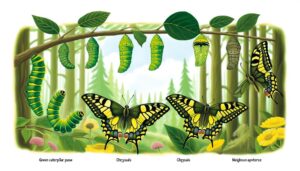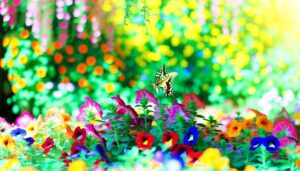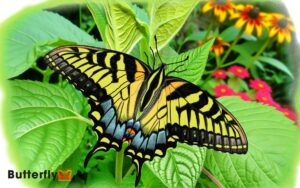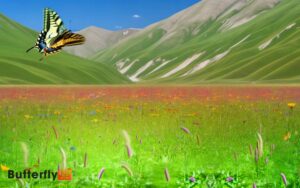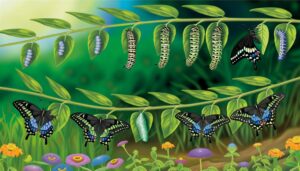How Does a Swallowtail Butterfly Eat?
Swallowtail butterflies exhibit specialized dietary behaviors across their life stages. During the larval stage, they consume specific host plants from the Apiaceae, Rutaceae, and Lauraceae families, demonstrating coevolutionary adaptations to detoxify plant chemical defenses.
Adults primarily forage on nectar-rich flowers like milkweed and lantana, crucial for their energy metabolism and reproductive success. Additionally, adult males engage in mud-puddling behavior to ingest essential minerals.
Regional variations influence their host plant preferences, supporting diverse ecological interactions. Understanding these dietary habits offers key insights into their ecological roles and conservation needs.
Continue exploring to discover more about their fascinating life cycle.
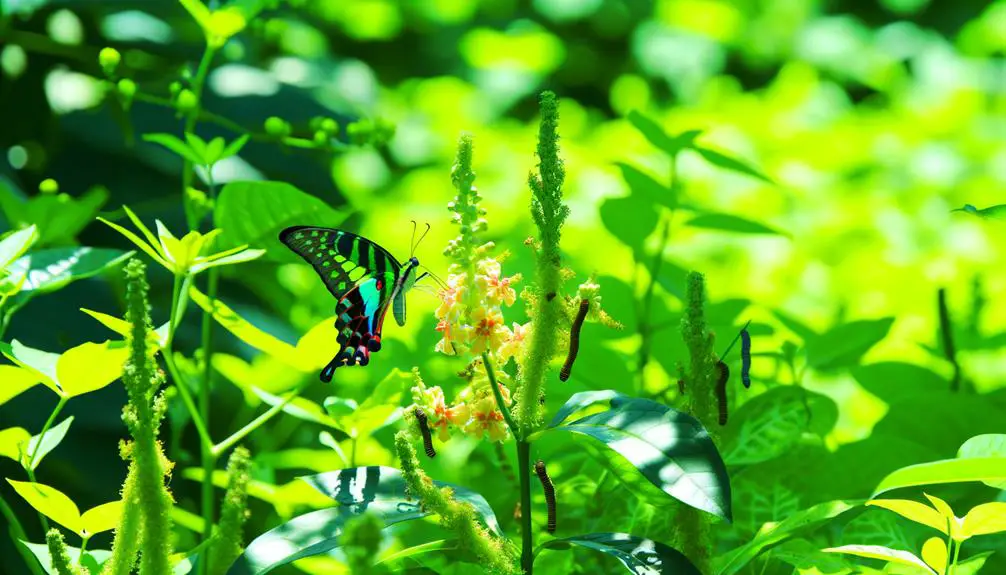
Key Takeaways
- Swallowtail caterpillars eat host plants from the Apiaceae, Rutaceae, and Lauraceae families.
- Adult swallowtail butterflies consume nectar from flowering plants like milkweed and lantana.
- Swallowtail larvae have specialized mandibles for efficient leaf processing of host plants.
- Adult swallowtails engage in puddling behavior to ingest minerals vital for reproduction.
Caterpillar Stage Diet
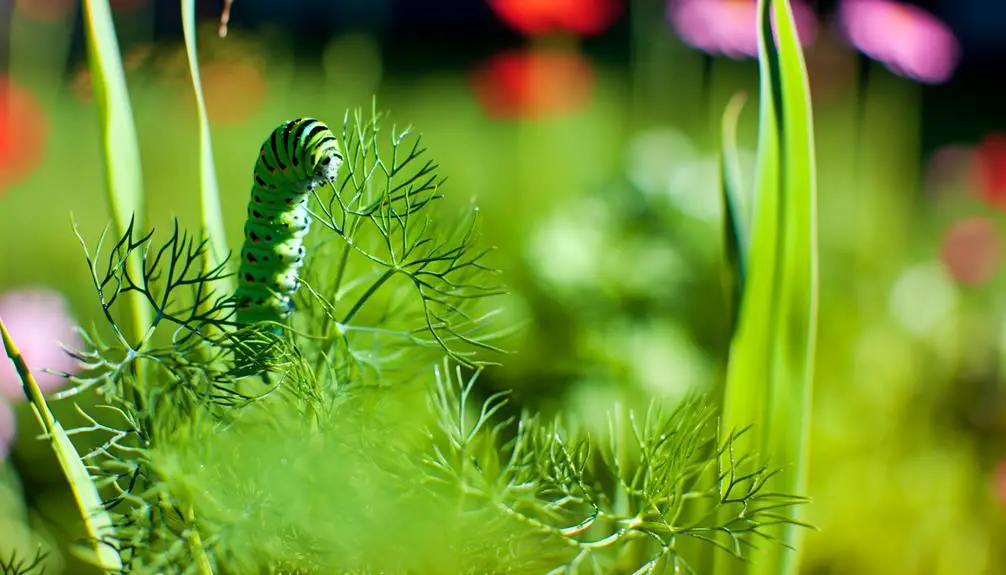
During the caterpillar stage, swallowtail larvae exhibit a highly specialized diet, primarily consuming host plants from specific botanical families. This specialization is a striking example of coevolution, where the larvae's digestive enzymes and feeding behaviors are finely tuned to metabolize the chemical compounds found in their host plants.
Observations reveal that these larvae utilize both visual and olfactory cues to locate their preferred foliage. Furthermore, their mandibles are adapted to efficiently process the leaves of these select plants, maximizing nutrient absorption.
This dietary specificity not only influences the larvae's growth rate but also affects their survival and development into adult butterflies. Understanding these intricate dietary preferences is essential for conservation efforts aimed at preserving swallowtail butterfly populations and their natural habitats.
Host Plants
Swallowtail butterflies exhibit a strong preference for specific host plants, primarily within the families Apiaceae, Rutaceae, and Lauraceae.
These plants often possess chemical defenses that caterpillar larvae have adapted to detoxify, enabling them to feed without harm.
Additionally, regional variations in host plant availability can substantially influence the distribution and dietary choices of swallowtail populations.
Preferred Host Plants
The diverse diet of swallowtail butterflies primarily includes host plants from the families Rutaceae, Apiaceae, and Fabaceae, which facilitate the caterpillars' growth and development. These families provide essential nutrients and chemical compounds necessary for larval stages. Observations indicate a strong preference for specific genera within these families, enhancing the swallowtail's survival and metamorphosis rates.
| Family | Example Genera | Specific Host Plants |
|---|---|---|
| Rutaceae | Citrus | Lemon, Orange, Grapefruit |
| Apiaceae | Daucus | Carrot, Parsley, Dill |
| Fabaceae | Senna | Senna, Cassia, Pea |
These plants offer not only sustenance but also strategic advantages in habitat selection, ensuring ideal conditions for the caterpillar's development and eventual transformation into butterflies.
Plant Chemical Defenses
Understanding the preferred host plants of swallowtail butterflies necessitates an examination of the chemical defenses these plants employ to deter herbivory while still supporting larval development. These plants often produce toxic secondary metabolites, which discourage most herbivores but have been adapted to by swallowtail caterpillars. Swallowtail butterfly defense tactics include enzymatic processes that neutralize these toxins, allowing the larvae to safely consume the otherwise harmful foliage. This evolutionary arms race highlights the intricate relationship between swallowtail butterflies and their preferred host plants.
Many host plants produce secondary metabolites, such as alkaloids, terpenoids, and glycosides, which serve dual functions: deterring generalist herbivores and acting as specific stimulants for swallowtail larvae.
For instance, the presence of furanocoumarins in the Apiaceae family not only deters non-adapted herbivores but also acts as a cue for Papilio species to oviposit.
Additionally, glucosinolates in Brassicaceae attract certain swallowtail species while repelling other insects.
These chemical compounds create a selective environment, where the larvae of swallowtail butterflies have evolved mechanisms to detoxify and utilize these substances, facilitating their survival and growth.
Regional Plant Variations
Regional variations in host plants greatly influence the distribution and dietary preferences of swallowtail butterfly populations.
Swallowtail larvae exhibit remarkable adaptability to diverse botanical environments, primarily consuming plants from the Rutaceae, Apiaceae, and Lauraceae families.
In North America, the Eastern Tiger Swallowtail (Papilio glaucus) favors Tulip Tree (Liriodendron tulipifera) and Wild Cherry (Prunus serotina), whereas in Europe, the Old World Swallowtail (Papilio machaon) chiefly feeds on Wild Carrot (Daucus carota) and Fennel (Foeniculum vulgare).
In Asia, the Common Mormon (Papilio polytes) is often associated with Citrus plants.
This regional specificity underscores the intricate interdependence between swallowtail butterflies and their host plants, mediated by evolutionary pressures and ecological niches, thereby driving their geographical and ecological diversity.
Adult Butterfly Diet
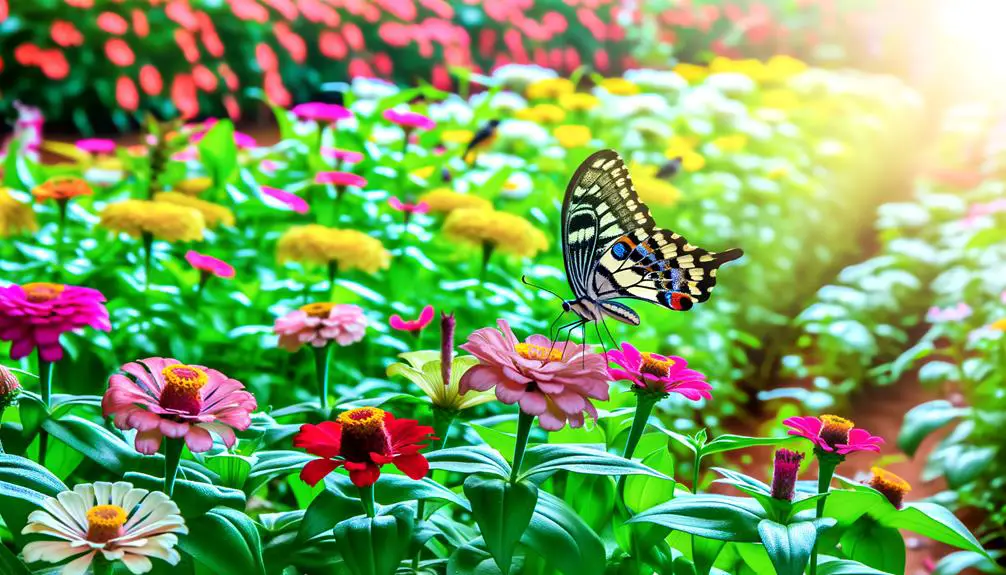
Adult Swallowtail butterflies primarily sustain themselves on nectar from a variety of flowering plants, which provides essential carbohydrates for energy.
Additionally, they engage in a behavior known as 'puddling' where they seek out and ingest minerals from moist soil, which is critical for their reproductive success.
Some species also consume pollen, which may offer supplementary nutrients such as proteins and lipids.
Nectar From Flowers
Among the various dietary sources for adult swallowtail butterflies, nectar from flowers serves as the primary and most important component of their nutritional intake. Nectar provides essential carbohydrates, which are crucial for energy metabolism and flight. Detailed observations reveal a preference for certain floral species, driven by the availability of nectar and flower morphology.
| Floral Species | Nectar Characteristics |
|---|---|
| Milkweed | High sugar content |
| Lantana | Abundant nectar supply |
| Butterfly Bush | Easily accessible nectar |
These butterflies exhibit selective foraging behavior, often visiting flowers with high nectar yields. The proboscis, a specialized feeding organ, allows efficient nectar extraction from tubular flowers. This symbiotic relationship between swallowtails and flowering plants promotes pollination, contributing to ecosystem biodiversity and resilience.
Pollen and Minerals
Swallowtail butterflies supplement their diet with pollen and minerals, which provide essential nutrients and contribute to their overall health and reproductive success. These added dietary components are vital for the butterflies' metabolic processes and longevity. Field observations and laboratory studies have revealed that adult swallowtails engage in behaviors such as mud-puddling to obtain these essential nutrients.
- Pollen ingestion: Offers proteins and amino acids.
- Minerals from soil: Provides sodium and other trace elements.
- Mud-puddling behavior: Commonly seen in males, aiding in reproductive vigor.
- Fecal matter and carrion: Unconventional sources of minerals.
These elements collectively enhance the swallowtail butterflies' ability to thrive in various environments, ensuring their resilience and adaptability.
Nectar Sources
Although swallowtail butterflies are known for their varied diet, nectar from flowering plants constitutes a primary source of nourishment, providing essential carbohydrates and energy.
These lepidopterans exhibit a preference for blooms with high nectar content, including species such as milkweed, lantana, and zinnias. The proboscis, a specialized feeding appendage, allows them to extract nectar efficiently from deep floral structures.
Observations indicate that swallowtails are particularly attracted to vibrant, fragrant flowers, which often signal abundant nectar reserves.
The symbiotic relationship between swallowtails and their floral hosts is critical for pollination. By transferring pollen while feeding, these butterflies contribute considerably to the reproductive success of numerous plant species, thereby maintaining ecological equilibrium.
Such interactions underscore the importance of conserving diverse floral habitats.
Mineral Needs
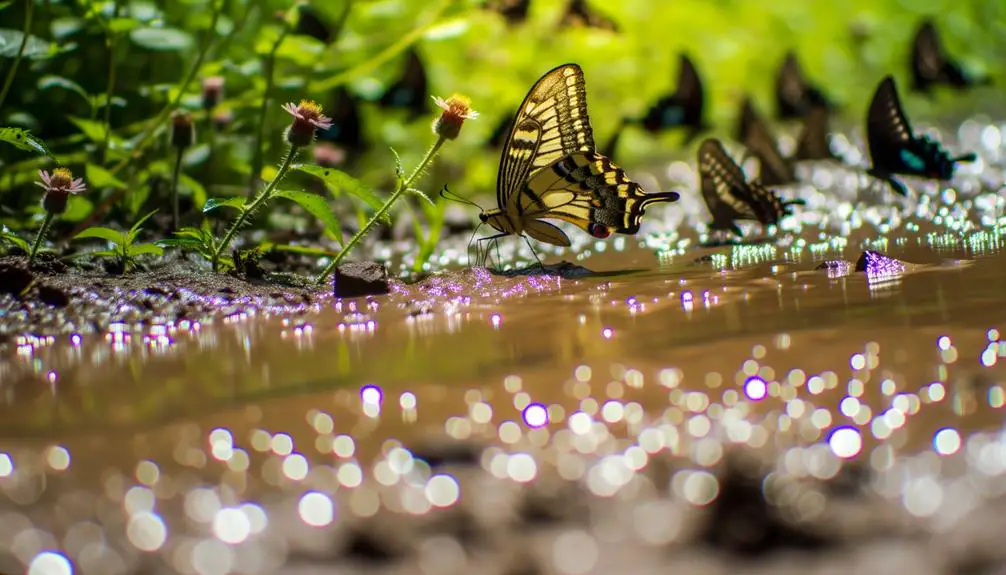
In addition to their reliance on nectar, swallowtail butterflies seek out minerals and salts from moist soil, decaying organic matter, and even animal excrement, a behavior known as mud-puddling.
This behavior fulfills their need for essential nutrients that nectar alone cannot provide.
These minerals are fundamental for various physiological processes, including:
- Reproductive Health: Enhances fertility and egg viability.
- Osmoregulation: Maintains fluid balance within their bodies.
- Muscle Function: Supports muscle contractions necessary for flight.
- Nervous System: Aids in proper nerve function and signaling.
Creating a Butterfly Habitat
Designing an ideal butterfly habitat involves meticulously selecting plants that provide both nectar sources and larval host opportunities, thereby supporting the complete life cycle of swallowtail butterflies. These habitats require a blend of specific flora to cater to adult and larval stages, ensuring sustainability and ecological balance. Nectar plants such as milkweed, phlox, and coneflower attract adult butterflies, while host plants like dill, fennel, and parsley are essential for larval development.
| Plant Type | Examples |
|---|---|
| Nectar Plants | Milkweed, Phlox, Coneflower |
| Larval Host Plants | Dill, Fennel, Parsley |
Incorporating these plants into a garden not only fosters biodiversity but also empowers individuals to contribute to conservation efforts, promoting an environment where swallowtails can thrive.
Conclusion
The lifecycle of the swallowtail butterfly is akin to a meticulously orchestrated symphony.
From the caterpillar stage's reliance on specific host plants to the adult butterfly's quest for nectar and essential minerals, each dietary requirement is a distinct note in the harmonious existence of this species.
Creating a butterfly habitat, consequently, mirrors the role of a composer, ensuring that every element is in place to sustain the butterfly's delicate balance in the ecological orchestra.


